By: Tracy L. Reynolds, AG Maritime and Space Law Ambassador
As humanity’s ambitions propel us beyond Earth’s boundaries, we find ourselves at the edge of a new legal frontier where established rules blur and uncertainty reigns. In the ever-expanding cosmos, traditional laws struggle to keep pace with rapid technological advances, commercial ventures and the profound complexities of space exploration. Welcome to the “cosmic gray zone,” a realm where international treaties, national interests and ethical dilemmas intersect and demand bold decisions and adaptive governance. This article delves into the legal ambiguities shaping our future among the stars and why navigating these uncharted territories requires not just regulation, but vision, collaboration and a steadfast commitment to shared principles.
What The Gray Zone Is…and Is Not
The term “gray zone” originated in a 2015 white paper by the United States Special Operations Command meant to describe the international relations spectrum between traditional war and peace activities.
Now, entities from Fortune 500 companies to academics use the term to describe any situation that requires a decision-maker to exercise discretion without a prescribed “right” or “wrong” answer. Businesses, as well as in federal or state regulation, companies and agencies often crave certainty and clear answers, so they refer to areas where no exact answer exists as the gray zone.
At its core, the gray zone concept attempts to address ambiguity.In law, people refer to the gray zone as that often uncomfortable space between definitive right and wrong, legal and illegal, ideal and impossible. It’s where the rules don’t quite fit a situation, the data is incomplete or values stand in juxtaposition.
Falling Into The Gray Zone Trap
In reality, no law or policy can completely predict future situations or provide a positive pathway for every plan. I would argue that there is no real gray zone in the law. Instead, there is a gray zone trap: a place of fear and uncertainty in situations where answers aren’t prescribed.
Yet decision makers often refer to these common situations as “legal gray zones:”
- Presence of Complexity: The real world is infinitely complex. Laws and policies, by necessity, generalize. No creator of law or policy can foresee every unique circumstance or nuance.
- Language and Interpretation: Words, even in statutes and contracts, remain subject to interpretation. For example, what does “reasonable force” mean? How should “fair use” be defined in a digital age?
- Unforeseen Circumstances: New technologies, social changes and global events constantly create situations the original rule-makers couldn’t have imagined.
- Conflicting Values: Societies operate on multiple, sometimes competing, values such as individual liberty vs. public safety, economic growth vs. environmental protection, justice vs. mercy. These often pull in different directions and create dilemmas where no single value can be fully maximized.
- Imperfect Information: Decisions often have to be made with incomplete data, future uncertainties, or a lack of full understanding of all potential consequences.
Space: More Gray Than Black or White
Nowhere are the gray zone situational characteristics more prevalent than issues relating to Outer Space. Several factors conspire to make outer space law particularly prone to the gray zone trap.
A Young and Evolving Frontier
Unlike millennia of Earth-based law, space law is barely 60 years old. It began with the 1967 Outer Space Treaty (OST), a foundational document crafted when humanity had only just begun to orbit the Earth. The OST and accompanying treaties provide a framework, not a prescriptive code. Some argue that the OST struggles to keep pace with rapid technological advancements and commercialization.
The Absence of a Global Sovereign
There is no single “space police” or “space court” with universal jurisdiction. While space is considered a shared heritage of mankind, individual nations are responsible for the activities of their governmental and non-governmental entities. This creates inherent tension and makes enforcement complex. Despite the fact that human activities in outer space continue to increase, there has not been sufficient nation state activity to establish legal obligations for customary international law. Also, no international outer space case law exists to provide insights into the adjudication of outer space disputes.
Earth-Bound Analogies Don’t Always Fit
While earth-bound legal concepts may be informative in outer space, analogies are not a replacement for careful thought. Concepts like “sovereignty,” “property,” “territory,” or even “crime” might take on new meanings (or might even lose meaning altogether) when applied to a vast, airless and potentially resource-rich void.
Dual-Use Technologies
Many space technologies have both peaceful and military applications. A satellite that monitors crops could also track military movements. This inherent duality makes it difficult, but not impossible, to draw clear lines regarding permissible activities.
Navigating the Gray Zone Trap in Space
The good news: we can learn to avoid the gray zone trap. A lack of certainty is not a flaw, but an inherent feature of our dynamic, complex world. It’s the space where judgment is exercised, creativity is sparked and ethical muscles are truly flexed.
By acknowledging the gray zone for what it truly is—an area of uncertainty where a decision maker must apply facts to the law and policy and face the consequences of making a choice—and preparing ourselves for these hard choices, we can move beyond the comfort of predetermined answers and mature into a more thoughtful, just and adaptive decision-making environment.
For example, rather than viewing OST as lacking current relevance, we should think of it as a valuable tool where existing international treaty law, applicable international law and nation state specific legal obligations provide guideposts to decision-making. (See prior AG coverage that discusses the OST here). Besides national law for space issues, decision makers can turn to other areas, such as the high seas or the electromagnetic spectrum, for guidance. The maritime environment, governed internationally by the UN Convention on the Law of the Sea, well-developed customary international law, and adjudicative decisions by court bodies, is particularly well suited to serve as a guiding light. Here are a few other areas of space law and how we might operate within the gray.
The Wild West of Resource Extraction: Who Owns the Moon and Asteroids?
The OST unequivocally states that “outer space, including the Moon and other celestial bodies, is not subject to national appropriation by claim of sovereignty, by means of use or occupation, or by any other means.” Does “national appropriation” prevent a private company from mining resources from an asteroid or the Moon and selling them?
The Gray Zone Trap: Many argue that while nations can’t claim ownership, the right to extract and own resources is not prohibited. Others contend that resource extraction, if done at scale, is a de facto appropriation. This fundamental disagreement lies at the heart of the emerging space economy.
What To Do: At the national level, at this point in resource extraction development, state involvement will likely be required to create the necessary infrastructure and process to make outer space resource extraction a realistic business model. On an individual level: ask the questions; be clear in contract bids responding to government interest; and simply become part of the conversation.
Jurisdiction and Crime: What Happens on the Space Station, Stays on the Space Station… Unless?
Imagine an incident on the International Space Station (ISS) involving astronauts from different countries. Whose laws apply if a crime is committed? What if a private lunar base is established?

The Gray Zone Trap: For the ISS, a complex web of intergovernmental agreements dictates jurisdiction which usually defer to the laws of the astronaut’s home nation. But as private space stations and permanent settlements emerge, this might not adequately address potential risks. Will Earth-based criminal codes be extended into space? What about “space-specific” crimes like reckless debris generation or unauthorized appropriation of resources?
What To Do: Don’t wait until launch to hash out jurisdictional issues. There is sufficient time to decide who is reasonable for what and how the process will adjudicate issues, in advance.
The Debris Dilemma: Who Cleans Up and Who Pays?
There are millions of pieces of space debris orbiting Earth, from spent rocket stages and defunct satellites to fragments from collisions. This “cosmic junk” poses a growing threat to active satellites and future missions. (See prior AG coverage of space junk here).

The Gray Zone Trap: While the OST holds launching states liable for damage caused by their space objects, identifying responsibility for existing debris, especially fragments from older collisions, is extremely difficult. Moreover, there’s no legally binding international framework for active debris removal. Is intentionally creating space debris (e.g., through anti-satellite missile tests) a violation of the OST’s “peaceful purposes” clause?
What To Do: The OST notes that international law applies in space. That means nation states can rely upon the creation of treaty law, current norms and customary international law to guide and direct the development of outer space law. Also, and probably more importantly, the OST requires notification of potentially impacted states by nation states when they plan to conduct certain activities in space. Notification, communication and conversation before, during and after outer space activities will be key to determining liability, sharing lessons learned and building the outer space legal regime.
Traffic Management and “Rules of the Road”: A Cosmic Orchestra without a Conductor
With mega-constellations of thousands of satellites becoming common, the risk of collisions continues to skyrocket (no pun). While countries are encouraged to coordinate satellite movements, there are no internationally binding “rules of the road” for orbital operations. Who has priority if two satellites are on a collision course? What constitutes reckless operation?
The Gray Zone Trap: Some argue that this lack of clear guidelines creates a free-for-all that endangers everyone’s access to space.
What To Do: Outer space domain awareness is happening now as the thousands of satellites currently in orbit engage in various activities. As technology advances, so does the ability by satellite operators to know more and make more informed decisions. Cultural norms and procedures are in use now to manage this evolving environment. These practices should be documented and shared to ensure current procedures are documented with an eye toward improvement as this area matures. Listen to active satellite operators, talk to ship drivers and create communication networks now. You cannot surge trust or create norms on the fly.
Addressing Cosmic Uncertainty…Together
When it comes to legal concerns in space, no single, perfect answer exists; only informed decisions. The long term goal of developing robust, adaptable frameworks for an ever-evolving environment must include:
- International Cooperation: No single nation can, or should, govern space. The OST framework is in place and has survived the last 60 years by articulating paramount guidance within which human activities may take place. Through international cooperation, with input from private companies, new agreements may be developed if required and can build on non-binding norms and best practices.
- Flexible and Adaptive Governance: Instead of rigid laws that quickly become obsolete, future space law might involve more framework conventions, voluntary guidelines and industry standards that can evolve as technology and activities change.
- Multi-Stakeholder Dialogue: Governments, private companies, scientists and civil society must all be part of the conversation. The commercial sector, in particular, is a powerful new actor that needs a seat at the table.
- Ethical Principles as Guiding Stars: Anchor decisions in shared ethical principles (e.g., sustainability, equitable access, avoiding harm, transparency) to inform decision frameworks with undergirding principles to shape a future of which we can be proud.
- Technological Solutions Alongside Legal Ones: Developing technologies for debris removal, autonomous collision avoidance or verifiable peaceful use can help mitigate risks.
The gray zone should not be used as an excuse to avoid difficult situations and hard choices. We can do hard things, even in the absence of predetermined processes and choices. Outer space is a difficult physical environment for human activities. It only makes sense that this difficulty is also an inherent part of the legal affairs in humanity’s greatest exploratory endeavor. How we navigate this ambiguity—with foresight, collaboration and a commitment to shared principles —will determine whether our future in space is one of boundless opportunity or perilous conflict. The stakes, literally, are out of this world.
*Tracy Reynolds writes for AG in her personal capacity. Any views or opinions expressed do not reflect those of the Department of Defense or the Department of the Navy.

